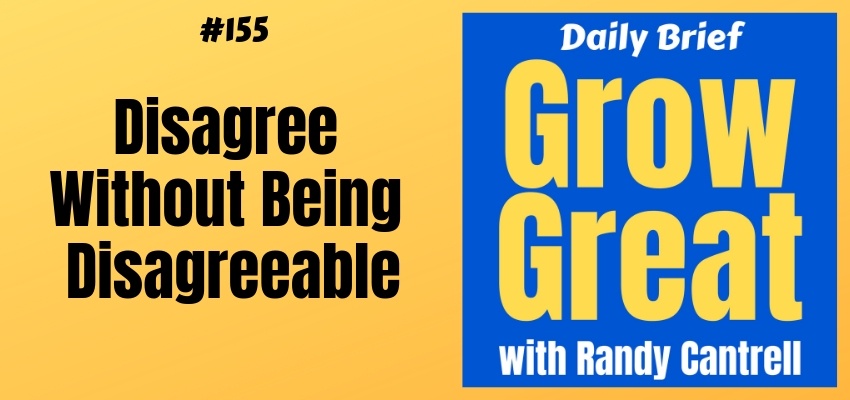Podcast: Play in new window | Download (Duration: 8:30 — 8.9MB)
Subscribe: Apple Podcasts | Spotify | RSS | More
Strife doesn’t build a stronger organization. Conflict won’t deepen a leader’s influence.
Confrontation is commonplace leadership topic. I often hear managers lament how they hate it and work hard to avoid it. Frequently they feel that confrontation is synonymous with strife and conflict. It’s not. Well, it doesn’t have to be.
Let’s talk about this and see if we can better understand how our leadership is too often damaged because we’re not seeing things clearly enough. Defining some terms can help. We’ll start with some dictionary definitions because that’ll help point out why we’ve got a problem.
Strife is angry or bitter disagreement.
Conflict (which is synonymous with strife) is a serious disagreement or argument.
Confrontation is a hostile or argumentative meeting or situation between opposing parties.
Do you agree with those definitions?
Let’s work in reverse now. Confrontation has another definition, based on the Merriam-Webster Dictionary. And this is the first definition listed.
“a face-to-face meeting”
Strife and conflict aren’t even third cousins to confrontation. But we confuse them. Easy to do because of the idiocy behind keyboards today where people can spew whatever venom they want. Daily we see folks dig into positions, stop up their ears, and refuse to listen long enough to understand anybody else, especially anybody who may disagree with them.
Waging war is easy. Understanding is hard. So too often people plant their flag and declare war!
Is it possible for your leadership and your culture to foster disagreement without increasing strife and conflict? Can people disagree in your organization without behaving poorly? Can people disagree without being disagreeable?
Of course, they can, but some things are mandatory.
Strong leadership is a must. Fairness and respect have to be protected.
Strong leaders understand that enthusiastic debate can fuel some of the best ideas and creative solutions. Rather than putting a negative connotation on the emotions, strong leaders help people harness those emotions toward learning, understanding and growth. Team members are encouraged to listen without judgment. Strong leadership can help show people the value of supporting the team’s effort, even though there may be disagreement over specifics. This largely happens when the leader keeps the team focused on the big objective. Disagreement over details doesn’t have to result in disagreement over what the team is trying to accomplish. Nor should it.
Safety and trust are required. If they don’t exist, all bets are off. Conflict is sure to follow.
Teams can build trust and safety. To elevate team performance, leadership must make those qualities top priority in the culture.
Intentions matters! If people are pursuing agendas other than those best for the group, then it’s easier for individuals to behave selfishly. Trust and safety don’t exist where selfishness is allowed.
Strong leaders are tough on intentions. People don’t behave perfectly. Sometimes we all mess up. But it’s very important that people learn to exhibit care and concern for the team and the team’s objectives.
“If your end of the boat sinks, so does mine.”
Strong leaders require behaviors to reflect that intention. They don’t allow anybody to violate that without great personal cost. It’s not being intolerant of individualism. It’s being intolerant of autocratic tyranny.
Ideas, opinions, and thoughts deserve to be tested. Vigorously.
If people can merely toss out some idea, or make some comment and not sustain a challenge…then that’s good for higher performance. That’s why disagreement is so highly valued. Truth and solid ideas are born from going through the fire of discussion and disagreement.
The best human advancements have been made because what was believed absolutely, positively true was challenged. And was unable to withstand the discussion of disagreement.
Prove it. Have your viewpoint. Listen to the viewpoint of others. Let them make you prove your viewpoint to be accurate. Make them prove their viewpoint. You’ll both emerge victors for your willingness to caringly challenging each other. I realize we rarely get to this point because we can get this far along on the path. Simply, we can’t get past our own pride, hubris, and selfishness.
Too many people don’t have an open mind. They too highly value their own viewpoint while simultaneously discounting the viewpoint of anybody else, especially those who disagree with them. Such people destroy the culture of high performance, which is why your strong leadership is so needed.
Being disagreeable means “marked by ill temper.” That’s what’s unacceptable.
Debate. Disagreement. Facing off with opposing viewpoints. Those aren’t automatically marked by ill temper, but it’s shocking how many people think so. Society isn’t helping matters any. Twitter wars abound. One person takes offense at another. And the fight is on. Keyboard shouting, accomplishing nothing, but strife. No learning. No understanding. No growth. An epidemic of dwarfism of ideas. Is that the culture you want inside your organization?
Then put in the effort to create an environment where people feel safe to disagree because they genuinely care about each other and doing the best work of their lives. Build a culture where people aren’t allowed to judge each other harshly, but where people are required to give grace to each other knowing that everybody has the best intentions to create the best solution.
Help your people disagree without being disagreeable.
Be well. Do good. Grow great!
RC
